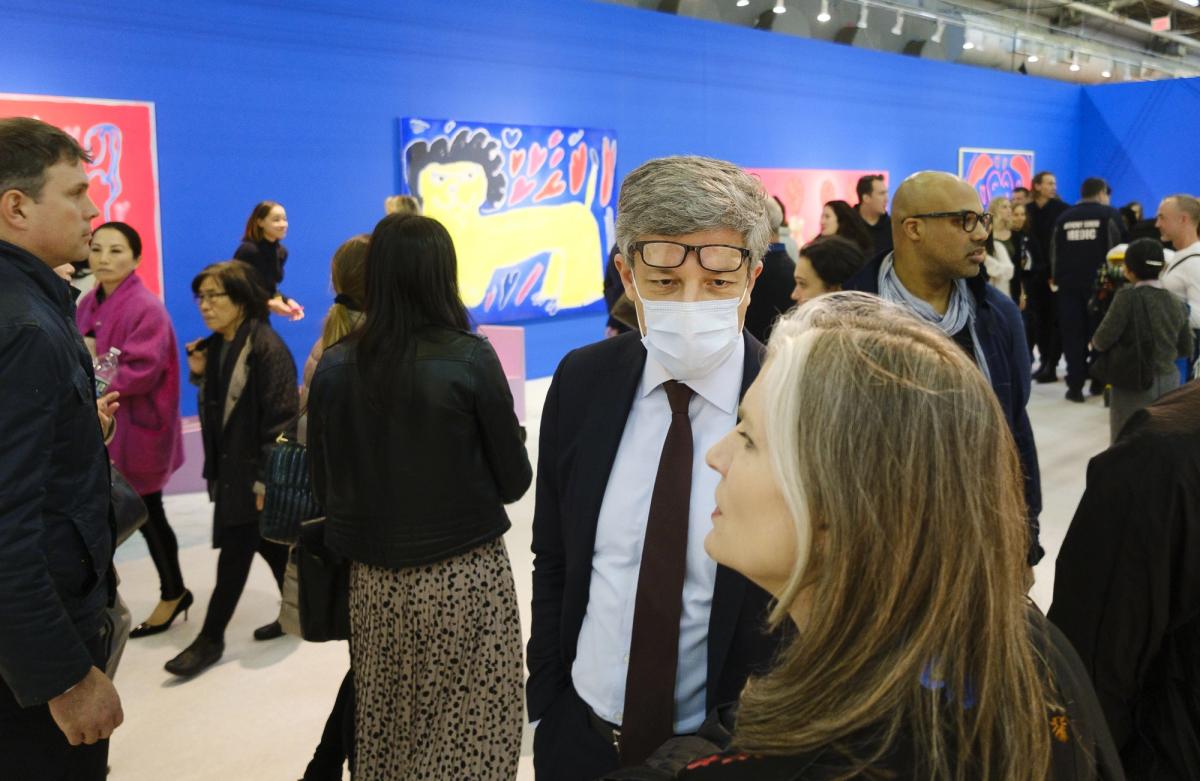Art fairs might be getting postponed and cancelled all over the globe due to the spread of coronavirus, but not New York’s Armory Show, the 26th edition of which opened at Piers 90 and 94 in Manhattan on Wednesday despite newly confirmed cases of the virus in New York. Visitors were largely cavalier about Covid-19, bumping elbows instead of shaking hands the most many were doing to limit potential contagion—a move that some jokingly called the “Arm-ory”. And while the global health crisis might have financial markets lurching, sales on the piers were as steady as the flow of hand sanitiser throughout the VIP day.
“I thought it would be quieter than it is,” says Stefano Di Paola, a director at Anat Ebgi. The Los Angeles-based gallery showed works by Amie Dicke and Janet Werner priced between $3,500 and $20,000, the majority of which had sold within the first few hours of the fair.
“Collector attendance seemed strong today and on a par with last year’s fair. We certainly had a very busy preview day,” says Swiss dealer Stefan von Bartha. The gallery sold German artist Imi Knoebel’s Anima Mundi 8-4 (2019) for around $120,000 and a new untitled work by Landon Metz for around $25,000 to US collectors and another of Metz’s works for $38,000 to a European collector.
The Miami-based David Castillo Gallery sold three recent works by Vaughn Spann for $50,000 each to private collectors from New York, Chicago and Florida and a quilt work by Sanford Biggers for $60,000 to a New York collector. London’s Jack Bell Gallery sold Lavar Munroe’s mixed media work 17/18 'WWJD' (2020) for $80,000 to a US-based private museum and Yavuz Gallery of Singapore sold Abdul Abdullah’s Custodians (2020) for $90,000 to a “large collection” in Miami.
What these sales seem to indicate is that, although of global renown, what the Armory Show has going for it amid a worldwide health crisis is that it is essentially a regional fair—a label it tries to avoid—but in an international behemoth of a city. Even without major international galleries headquartered in New York like Pace and David Zwirner as exhibitors, the show is kept afloat year after year thanks to its wide pool of New York and US buyers. And as major US museums like the Met in New York and the Art Institute of Chicago place international travel restrictions on their staff in response to more Covid-19 outbreaks in Europe and beyond, a domestic fair with global heft like the Armory steps back into pride of place this year.
To that end, Nicole Berry, the Armory Show’s director, affirmed exhibitors via a statement beforehand that the fair is following all recommendations from the Center for Disease Control and the World Health Organization and will continue to do so throughout the run of the event. Signs are posted at both pier entrances on best practices for health, hand sanitiser stations are clearly marked and installed on the fair floors and "we put bottles of hand sanitiser in every exhibitor bag", Berry says.
Nevertheless, of the roughly 180 exhibitors from 32 countries at this year’s edition, two Asia-based galleries—Pearl Lam and ShangART—were not in attendance despite originally being listed among the participants, though the fair did not confirm coronavirus as the reason for their absence. Galleries coming from Italy, which suffered a large outbreak and many museum and school shutdowns last week, were still in attendance though some dealers noted European VIPs were fewer on the ground but still buying via advisers and reaching out over email.
The greater issue facing Armory long term than a possible pandemic this year may simply be competition in the US fair calendar as February’s Frieze Los Angeles grows in repute and, closer to home, the increasing pull of Tefaf New York Spring amid Frieze week in May, not to mention Independent and ADAA’s The Art Show near Armory Week.
Yet, even with all the alternatives, Armory boasts the brand power to give a gallery’s programme a boost. “I’d say it is the most significant New York fair still, people pay attention to it,” says Robert Dimin of New York’s Denny Dimin gallery, which participates in the fair for the first time this year and had sold the majority of its presentation of Amir H. Fallah’s paintings by Wednesday afternoon, priced from $14,000 to $28,000. “You have to do it at least once. It’s kind of like a bucket list event.”
Perhaps that is why despite falling just three weeks after Frieze Los Angeles, LA galleries were a huge presence at the Armory Show this year. Roberts Projects sold a mixed-media piece by Betye Saar for over $1m. Kayne Griffin Corcoran sold three Mary Corse paintings ranging from $45,000 to $280,000, and new works by the likes of Hank Willis Thomas and Mika Tajima.
Meanwhile, Kohn gallery reported that a large-scale painting by Caroline Kent was acquired by a major institution in Texas while a recent multi-media sculpture by Chiffon Thomas went to a Northeastern US museum; an embroidered work by Sophia Narrett, who the artist only recently began representing, was purchased as a promised gift to a west-coast museum. Night Gallery sold a work by Christine Wang to a private collection and a Cynthia Daignault work for $16,000 while Nicodim Gallery sold works by Dominique Fung, Devin B. Johnson, Daniel Pitín, Hugo Wilson and Simphiwe Ndzube ranging from $12,000 to $50,000.


